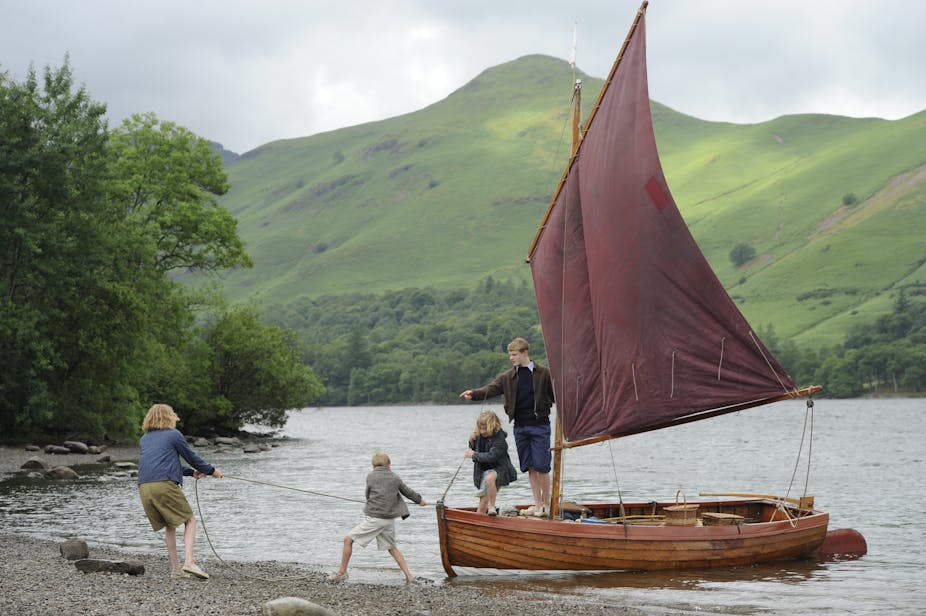The hotly anticipated Swallows and Amazons film will introduce a whole new generation to the tales and adventures of John, Susan, Titty (renamed Tatty for a modern film audience) and Roger – who spend their summer holidays sailing, camping, fishing and exploring on the great waters and hills of the Lake District.
For many modern viewers, stories of exploration and piracy, may seem quite far removed from children’s lives today – the characters in the book are free to go off and explore by themselves for most of the summer holidays, which is a lifestyle that many of today’s British children don’t know much about.
In the novel, the children require physical and emotional distance from the adults and adult-controlled perceptions of the world. This is crucial to the kind of childhood engagement with the landscape that they experience and the sense of escapism they are able to achieve.
At the same time, the question of how much independence is appropriate is raised in each book by near disasters – including the children sailing at night alone with the potential of crashing or getting injured and lost on the hilltops. For any modern parent, one of the most striking features of the narrative is the high level of freedom the children are allowed – far higher than any parent would be happy with today.
Of course, in writing Swallows and Amazons, the book’s author Arthur Ransome was himself escaping into his own remembered past, to a place of childhood memories of Lake District holidays spent outdoors while his academic father – a professor of history at the University of Leeds – marked scripts and undertook some desultory research.
And Ransome needed to escape – from a world turned upside down. Ransome was war correspondent for the Daily News, reporting first from the Russian Front and then on the early stages of the Russia Revolution. A strong Bolshevik sympathiser he played chess with Lenin and went on to marry Trotsky’s secretary, Evgenia Shelepina, after he had divorced his first wife. The two of them escaped Russia in 1919 and lived in the Baltic states for five years before returning to England and the Lake District.
There have also been claims that Ransome was a spy for the Foreign Office but his strong sympathy and personal friendships with the revolutionaries make this questionable.
An imagined place
Swallows and Amazons is primarily set around a lake which resembles Lake Coniston, with the hill of Coniston, also known as The Old Man of Coniston behind. But it also draws upon Windermere for the town on the lake and the island, as well as Derwent Water for the “peak at Darien”. In relation to this merged geography Ransome explained:
There has to be a little pulling about of rivers and roads, but every single place in all those books exists somewhere and by now I know the geography of the country in the books so well that when I walk about in actual fact, it sometimes seems to me that some giant or earthquake has been doing a little scene-shifting overnight.
For the author, it is clear that the imaginary geography of the book almost replaces the real so that it is the world of “actual fact” that appears distorted. But this idealised montage of all the best bits of the landscape also proves crucial to the sense of place that the children in the book are able to experience.

This is because it allows them to reject reality and make their own map of the world they inhabit. They take imaginative possession of the island that they sail to and camp out on by renaming it and everything seen from it.
After that they were tired and went up to the lookout place to watch the shipping on the lake and to agree about the names for all the places on the island.
Literary lands
It is clear, that works of literature about place allow the reader to escape into an earlier, easier world – and in the case of the Lake District, a world fixed in that perfect past by virtue of being a National Park.
This type of literary tourism seems to be a peculiarly British phenomenon – think Shakespeare’s Stratford, Dickens’ London, The Bronte’s Yorkshire, Hardy’s Wessex – but one that is attractive to visitors worldwide.
And with the release of Swallows and Amazons, it may well be that more children want to head to the Lake District to follow in the footsteps of John, Susan, Titty and Roger, spending their time canoeing or building campfires, and reconnecting with nature.

So, in the wake of Brexit, let’s turn our backs on the troubling present, remove ourselves from the pressures and tensions of globalisation, and retreat to the rural English landscape and fond memories of long, hot summer holidays. And what better way to do it than through Arthur Ransome’s idealised Lake District childhood in Swallows and Amazons.

